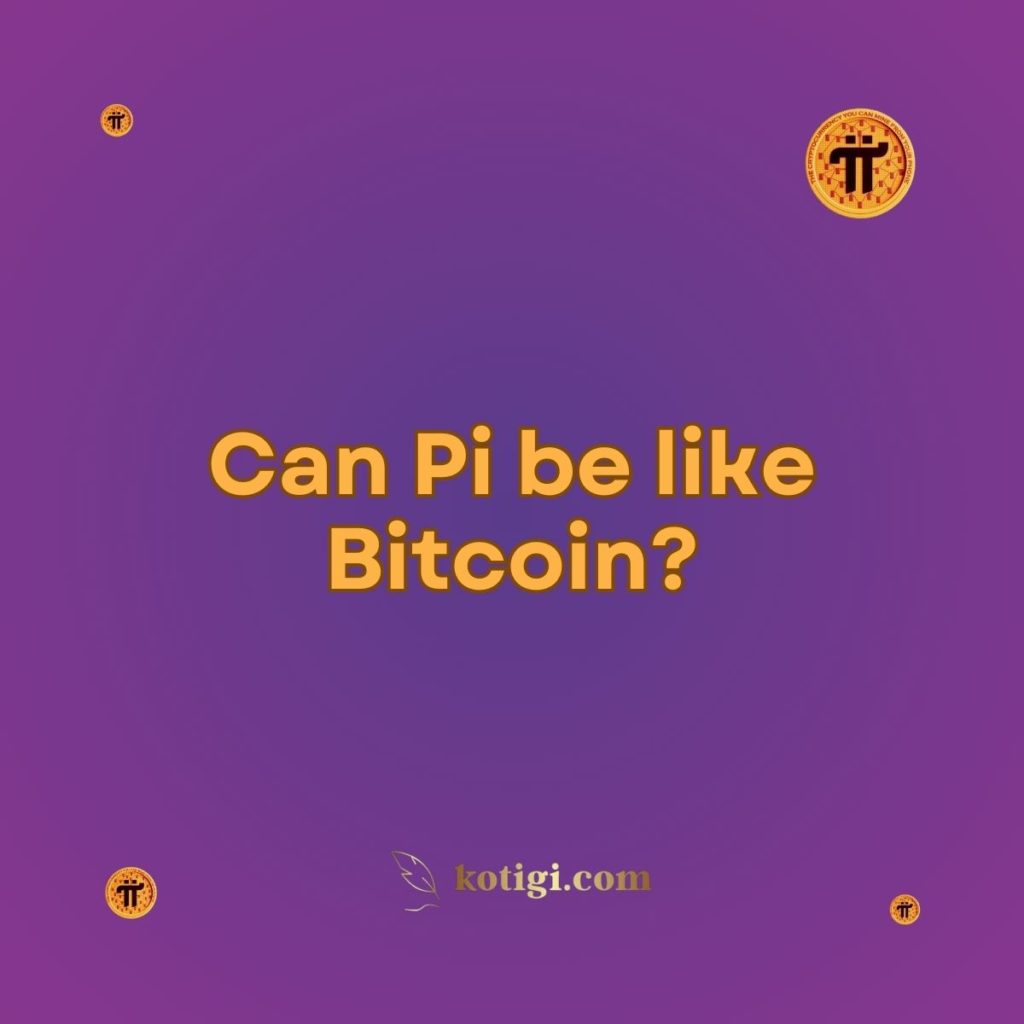
Can Pi be like Bitcoin?
No, Pi Network is unlikely to become like Bitcoin. While Pi has a large user base and a unique mobile mining model, it differs from Bitcoin in terms of technology, adoption, and scarcity. Bitcoin’s decentralized nature, established market value, and widespread adoption give it an edge, while Pi is still in development, with many unknowns regarding its future as a tradable and valuable cryptocurrency.
Introduction
Pi Network is an ambitious cryptocurrency project that has captured the interest of millions globally. With its unique mobile-based mining process, Pi has positioned itself as a more accessible alternative to Bitcoin. However, the question remains: Can Pi become as valuable and influential as Bitcoin?
Bitcoin, as the first decentralized cryptocurrency, revolutionized the financial world by introducing blockchain technology and enabling peer-to-peer transactions without the need for intermediaries. Pi Network, on the other hand, aims to make cryptocurrency accessible to everyone through a mobile-based mining model that does not require expensive hardware. While Pi’s vision is promising, its path to becoming like Bitcoin is filled with both opportunities and challenges.
Comparison Table
Here’s a comparison table:
| Feature | Pi Network | Bitcoin |
|---|---|---|
| Technology | Mobile-based mining using the Stellar Consensus Protocol (SCP) | Proof-of-Work (PoW) with energy-intensive mining |
| Mining Equipment | Can be mined on smartphones without specialized hardware | Requires powerful, specialized hardware (ASICs) |
| Energy Consumption | Energy-efficient, minimal consumption | High energy consumption due to PoW mining |
| Adoption Stage | Still in development, not yet traded publicly | Widely adopted, accepted as a store of value and digital gold |
| Market Availability | Enclosed mainnet phase, not listed on exchanges | Traded on major cryptocurrency exchanges globally |
| Scarcity | Unlimited supply (so far) | Fixed supply of 21 million coins |
| Value | No determined market value until open mainnet and exchange listings | Established market value, seen as an investment and hedge |
| Utility | Focused on real-world applications in the future ecosystem | Primarily used as a store of value, limited transactional use |
| Decentralization | Currently centralized with plans for future decentralization | Fully decentralized, no central authority |
| Community | Large, active global community | Global community with strong network effects |
| Regulatory Challenges | Faces potential future regulatory hurdles | Established but still subject to varying regulations globally |
| Merchant Adoption | Limited, early-stage ecosystem | Increasing acceptance by merchants worldwide |
| Network Security | Not yet proven at scale | Highly secure, backed by decentralized mining power |
| Future Potential | Still in development with many unknowns | Proven track record as the first and leading cryptocurrency |
This table highlights the differences and similarities between Pi Network and Bitcoin, emphasizing the key areas where Pi still has room to grow before reaching Bitcoin’s level of success.
Differences Between Pi and Bitcoin
Technology and Mining Process
Bitcoin uses a Proof-of-Work (PoW) consensus mechanism, which requires miners to solve complex cryptographic puzzles using high-powered computers. This process is energy-intensive and often requires significant financial investment in hardware. In contrast, Pi Network uses a mobile-based mining process that is energy-efficient and does not require specialized equipment. Pi’s consensus mechanism is based on the Stellar Consensus Protocol (SCP), which allows users to participate in securing the network without consuming significant resources.
The difference in mining processes is a key distinction between Pi and Bitcoin. While Bitcoin mining has been criticized for its environmental impact, Pi’s approach is designed to be more sustainable and user-friendly, allowing individuals to mine Pi on their smartphones with minimal effort.
Adoption and Market Penetration
Bitcoin has been in the market for over a decade, and during this time, it has achieved significant adoption both as a store of value and a medium of exchange. It is often referred to as “digital gold” due to its limited supply (21 million coins) and its use as a hedge against inflation. Bitcoin is also widely accepted by merchants, financial institutions, and even some governments as a legitimate asset class.
Pi, on the other hand, is still in its developmental stage. While Pi boasts a large user base, it has yet to achieve the same level of adoption as Bitcoin. Pi is still in its enclosed mainnet phase, meaning it cannot be traded on public exchanges, and its utility in the real world is limited. For Pi to reach Bitcoin’s level of adoption, it will need to transition to the open mainnet, be listed on major exchanges, and gain acceptance as a legitimate currency or asset.
Scarcity and Supply
One of the key drivers of Bitcoin’s value is its scarcity. With a hard cap of 21 million coins, Bitcoin’s supply is finite, which has contributed to its rise in value over time. As demand for Bitcoin has grown, its limited supply has resulted in price increases, making it a highly sought-after asset.
Pi, on the other hand, does not have a set maximum supply at this time. The Pi Network’s supply is determined by the rate at which users mine Pi, and the project’s team has not yet announced a final cap on the total number of Pi coins that will be in circulation. Without a clear limit on supply, Pi may struggle to achieve the same scarcity-driven value as Bitcoin.
Utility and Real-World Use Cases
Bitcoin’s primary use case has evolved over time. While it was initially intended as a decentralized currency for peer-to-peer transactions, it has become more commonly used as a store of value and investment asset. Many people view Bitcoin as a hedge against traditional financial markets and inflation.
Pi Network, however, is still building its ecosystem. The project’s team is working on developing use cases for Pi coins, such as enabling users to purchase goods and services within the Pi ecosystem. For Pi to rival Bitcoin, it will need to demonstrate real-world utility beyond just being a digital asset. This could include integration with payment systems, partnerships with merchants, and the development of decentralized applications (dApps) within the Pi ecosystem.
Potential for Pi to Achieve Bitcoin’s Success
Community and User Base
One of Pi Network’s strongest assets is its large and active community. With millions of users worldwide, Pi has the potential to drive significant network effects. A large user base is crucial for the success of any cryptocurrency, as it ensures liquidity, adoption, and real-world use.
Bitcoin also started with a small community of early adopters, but it gradually grew into a global movement. If Pi can leverage its community and continue to expand its user base, it may be able to follow a similar path. However, building a strong community alone is not enough — Pi must also offer value and utility to its users.
Path to Decentralization
Bitcoin is fully decentralized, with no central authority controlling the network. This decentralization has been a key factor in Bitcoin’s success, as it ensures that no single entity can manipulate the currency or its transactions.
Pi Network, on the other hand, is currently in a more centralized phase, with the project’s core team overseeing much of its development. While Pi has plans to move toward greater decentralization over time, this transition is crucial if Pi is to be seen as a true competitor to Bitcoin. Full decentralization would increase trust in the network and make it more resilient to external threats.
Open Mainnet and Exchange Listings
For Pi to be like Bitcoin, it must first transition to its open mainnet. This is the point when Pi coins will become tradable on public exchanges, allowing users to buy, sell, and trade Pi in the open market. Without an open market for Pi, it cannot achieve the same level of liquidity and price discovery as Bitcoin.
Once Pi is listed on major cryptocurrency exchanges, it will be exposed to the same market forces that have driven Bitcoin’s price increases. However, the success of Pi on exchanges will depend on its perceived value, utility, and the confidence of its community.
Challenges Pi Faces in Becoming Like Bitcoin
Regulatory Uncertainty
One of the biggest challenges facing Pi is regulatory uncertainty. Cryptocurrencies, in general, face varying degrees of regulation across different countries. For Pi to succeed on a global scale, it will need to navigate these regulatory hurdles and ensure compliance with local laws. Bitcoin, too, has faced regulatory challenges, but its decentralized nature has allowed it to thrive despite government scrutiny.
If Pi cannot overcome regulatory obstacles, it may struggle to gain the same level of legitimacy and acceptance as Bitcoin.
Market Competition
Bitcoin is the dominant cryptocurrency in the market, and it has established itself as a leader in the space. Pi faces stiff competition from other cryptocurrencies, including Ethereum, Litecoin, and newer projects that offer similar features or value propositions.
For Pi to differentiate itself and compete with Bitcoin, it will need to offer something unique — whether it’s a more accessible mining process, innovative use cases, or partnerships with major players in the industry.
Price Volatility and Stability
Like all cryptocurrencies, Pi will likely experience price volatility once it becomes tradable on exchanges. Bitcoin has seen massive price fluctuations throughout its history, which has made it both a lucrative investment and a risky one. If Pi wants to attract long-term users and investors, it will need to demonstrate some level of price stability, which is often achieved through widespread adoption and real-world use.
The Future of Pi: Can It Be Like Bitcoin?
Merchant Adoption
For Pi to reach the same level of success as Bitcoin, it will need to be widely accepted as a form of payment by merchants around the world. Bitcoin has made significant strides in this area, with companies like Tesla, Overstock, and others accepting Bitcoin for goods and services.
Pi is still in the early stages of building its merchant ecosystem, but there are already marketplaces within the Pi community where users can exchange Pi for goods and services. Expanding this ecosystem and partnering with larger merchants will be critical for Pi’s future success.
Network Security and Trust
Bitcoin’s security is one of its most important features. Its decentralized nature, combined with a robust network of miners, makes it highly resistant to attacks. Pi Network must prioritize security as it grows, ensuring that its network is resilient to hacking and other threats. Trust in the network is essential for long-term adoption and value.
Conclusion
While Pi Network has the potential to be a significant player in the cryptocurrency space, it faces many challenges before it can truly be compared to Bitcoin. Pi’s unique mobile-based mining process, large user base, and focus on accessibility give it a strong foundation. However, its path to becoming like Bitcoin will depend on factors such as decentralization, regulatory compliance, market adoption, and utility.
Pi can certainly carve out its own niche in the cryptocurrency world, but whether it can achieve the same level of influence and value as Bitcoin remains to be seen. Only time will tell if Pi can follow in the footsteps of Bitcoin’s meteoric rise.
Key Takeaways:
- Pi Network is often compared to Bitcoin, but it has a long way to go before reaching the same level of adoption and value.
- Pi uses a mobile-based mining process, making it more accessible than Bitcoin, which requires energy-intensive mining.
- The transition to the open mainnet and listing on public exchanges will be critical for Pi’s success.
- Pi faces challenges such as regulatory uncertainty, market competition, and the need for merchant adoption.
- Pi has the potential to succeed but will need to demonstrate real-world utility, security, and decentralization to achieve Bitcoin-like status.





